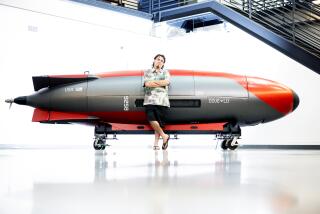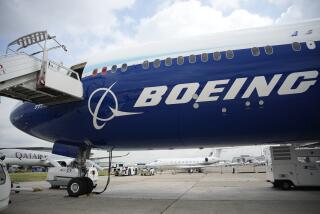Drone maker AeroVironment sputters as defense spending dries up
At the height of the wars in the Middle East, AeroVironment Inc. — a drone maker based in Monrovia — soared into the public limelight.
In the last decade, AeroVironment became the Pentagon’s top supplier of small drones. Its financial balance sheet prospered, its drones delivered results and its technology landed on the cover of Time magazine as one of the year’s best inventions in 2011.
But these days, not so much.
Over the last month the company’s shares have plummeted more than 18% as federal spending begins to dry up and the wars in Iraq and Afghanistan come to an end. It lowered its revenue guidance by nearly one-third, to $230 million to $250 million from $348 million to $370 million.
“We have seen delays in U.S. government procurement of our small unmanned aircraft systems … resulting from ongoing federal budget uncertainty,” AeroVironment Chief Executive Timothy E. Conver said. “Those delays impacted our current year results, requiring us to reduce our fiscal 2013 guidance in our third-quarter earnings release.”
Conver owns 12.7% of the company’s stock. Last year, he owned more than 14%.
The company’s small robotic planes, which are designed to fit into a soldier’s rucksack and then be tossed into the sky like a football, give troops on the ground a bird’s-eye view of what’s happening over a ridge or around a bend.
In March, AeroVironment posted that its drone sales for its fiscal third quarter fell 34.1%, to $37.7 million from $57.2 million in the same quarter last year. The company reported net income of $3.9 million, or 17 cents a share, for the quarter that ended Jan. 26. Analysts on average had forecast earnings of 37 cents a share.
Analysts at Arlington, Va.-based FBR Capital Markets said in a recent note to investors that AeroVironment is one of the defense companies most at risk and cut its target price for buying the stock in half.
“Based on the lower guidance and general head winds related to procurement and order timing, we are lowering our price target from $35 to $19,” the investment bank said.
AeroVironment shares rose 4 cents to $18.02 on Wednesday.
Few aviation buffs would have predicted that a company that initially started in 1971 as a research outfit that focused on solar and electric power technologies would become a major player in the fast-evolving world of tiny robotic planes.
Founded by the late aviation pioneer Paul B. MacCready, AeroVironment’s aviation ambitions began with attempts to win a much-needed $100,000 prize for the first human-powered airplane. It won the prize with Gossamer Condor, which hangs at the National Air and Space Museum.
MacCready then built the Gossamer Albatross, which crossed the English Channel on pedal power.
All the while, quietly in the company’s backrooms, engineers were also dabbling in a new frontier in aviation — making planes ever smaller and closer in design to small birds. That research paid off after the Sept. 11, 2001, terrorist attacks as the Pentagon began to look for ways to protect U.S. troops from elusive insurgents.
It wasn’t long after the World Trade Center twin towers fell in New York that the Pentagon went looking for new technology for the guerrilla-type warfare it would face in the Middle East.
When special forces units were dispatched in 2001 to the desolate outcroppings of Afghanistan to stalk and eradicate the Taliban, the commandos were outfitted with radios, night-vision goggles and automatic rifles. But they also carried a tiny robotic spy plane, so small it would fit in a backpack. The technology enabled them to avoid ambushes and pinpoint the location of enemy positions.
AeroVironment went on to develop an array of the small drones — including the Raven, Wasp, Puma and Switchblade models — that quickly became a staple of U.S. military operations. Its technology fueled the growth of the once-tiny company into a publicly traded defense contractor by 2007 with thousands of drones at work in the war zone.
The company’s annual sales went from $29.4 million before the war to $325 million last year. About 83% of AeroVironment’s revenue comes from the federal government.
Andrew Carolus, an investment banker with Mesirow Financial Holdings Inc., said larger defense companies have longer contracts, more diverse portfolios and are better-positioned to withstand the downturn in sales coming in the defense sector.
“AeroVironment is trying to find other ways to utilize their technology,” he said. “The company has exceptional engineering and has looked for ways to diversify for a while now.”
Although AeroVironment recognizes its reliance on the military, the company still has high hopes. It makes and sells charging systems for electric vehicles. For instance, it makes residential charging stations for the Nissan Leaf and continues to expand internationally.
The company, which makes its small spy drones in Simi Valley, hopes to diversify its customer base in the coming years with the Federal Aviation Administration’s impending introduction of regulations that would allow small drones into U.S. airspace in 2015.
Currently, drones are not allowed to fly in the U.S. except with special permission from the FAA. But as interest in drones has increased among police departments and businesses, the agency has appeared willing to ease restrictions.
More to Read
Inside the business of entertainment
The Wide Shot brings you news, analysis and insights on everything from streaming wars to production — and what it all means for the future.
You may occasionally receive promotional content from the Los Angeles Times.











